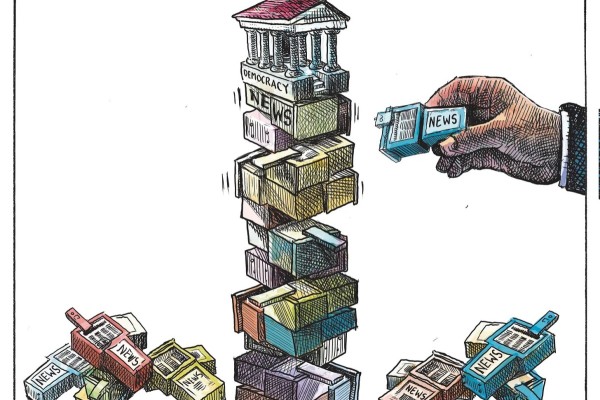Is journalism really dying? No, it’s just evolving
Edge: The undeniable human impulse to consume news means journalism is far from dead

A recent spate of bad news for the news business has triggered yet another round of lamentation that journalism is dying, which is kind of funny when you think about it in the broad sweep of history. When you pull back your camera for a really wide-angle view of what has been going on for the past few decades, maybe a century for a good sample size, you start to see things a bit differently. I say this as a journalism historian who has studied the business side of news media for the past quarter century, written a half-dozen books on the subject, and followed recent developments closely for the past couple of years as media columnist for this publication. From this perspective, I can see that what is going on is a slow and sometimes painful process of evolution, but others with a narrower view see it as a dying off and conclude too quickly that it must be an extinction event. The problem is that I am now starting to lose my few allies in this long-running debate, so I guess I’ll just have to make my case more persuasively.
Jack Shafer at Politico, who has been a staunch defender of newspaper viability, seems to now be starting to lose his nerve with the latest bad news. As recently as October, Shafer was deriding the doomsayers, quipping that “like a bed-sored and gasping patient on a gurney who has shed all life support, the newspaper continues to decline its death sentence.” Now he surveys the latest damage—mass layoffs at the Los Angeles Times, Time magazine, Sports Illustrated and Business Insider—and seems to be wavering. “It would be far too dramatic to extrapolate from the disastrous week that journalism itself is dying,” he writes. “The journalism party might not be completely over. It’s human nature to interpret any bad news as the coming apocalypse.”
New @politico: The Death Rattle of the News Business https://t.co/kATdWnR56e
— Jack Shafer (@jackshafer) January 27, 2024
Shafer points to City University of New York (CUNY) journalism professor Jeff Jarvis, who is perhaps the most sensible of the digital media gurus, as having now “folded his hands in his lap like a mortician” with the latest news. “I am coming to a conclusion I have avoided for my last three decades working on the internet and news,” writes Jarvis in his latest blog entry. “It may finally be time to give up on old journalism and its legacy industry.” Jarvis points not just to the latest layoffs, but to the arrival of artificial intelligence, cratering trust in journalism and turmoil at the Daily Mirror in the UK as further proof that legacy media are beyond salvation. “I wonder whether it is time [to] stop throwing good money and effort after bad,” he muses. “The old news industry has failed at adapting to the internet and every one of their would-be saviors—from tablets to paywalls to programmatic ads to consolidation to billionaires—has failed them” (at this point I started going off on a tangent about Jarvis, which I decided to instead post on my own blog).
Then there is my academic ally Iris Chyi of the University of Texas, who also seems to be getting cold feet. Iris has long studied the news media’s online transition, most hilariously in her 2013 book Trial and Error: U.S. Newspapers’ Digital Struggles Toward Inferiority. As recently as 2019, I was able to get her to testify that newspapers were not dying. “The key lies in readers’ stronger-than-expected attachment to the print format,” she told a panel I organized at a journalism conference in Toronto. “With an attachment this strong, print does not have to die.” Her latest research, however, shows that while newspaper digital subscriptions surged with the pandemic, that has since faded and rates for digital subscriptions remain low. The cost of print subscriptions has meanwhile soared, in many cases to more than $1,000 a year, as newspapers try to run off their last print subscribers in the hope of converting them to digital subscribers. “The seemingly promising increase in digital subscriptions during COVID-19 could not generate nearly as much revenue to cover the loss on the print side, resulting in a substantial loss in total subscription revenue,” Chyi concludes, warning: “The state of the US newspaper industry needs immediate attention.”
Well, I guess that just leaves little old me. First let me say, as Shafer and Jarvis do, that journalism is not dying. It will always be with us, and anyone who doubts that should read Mitchell Stephens’ brilliant book A History of News, which chronicles the undeniable human impulse to both spread and consume news. Second, as I have long been saying, layoffs don’t necessarily mean that news media are dying. They could be a sign that they are adapting and, better yet, are able to pivot and thus survive.
The biggest question now is what kind of shape news provision will be in when newspapers finally crash and burn, not because anybody reads newspapers anymore, but because newspapers still provide most of the news most of us read for free online. I still firmly believe, as outlined in my 2014 book Greatly Exaggerated: The Myth of the Death of Newspapers, that print will survive in some diminished capacity. Newspapers that have not fallen into the clutches of private equity players and US hedge funds, after all, are making a successful transition to hybrid print and digital publications that rely more on reader revenues than on advertising. By investing in quality content and a successful online subscription scheme, the Globe and Mail has led the way in this country.
The problem, here as in the US, is that most of the newspaper industry is in the clutches of private equity players and US hedge funds, which are hindering their transition to the digital world by cutting their costs and stripping their assets in a short-term “harvesting” strategy. It’s a long story, which I tell in my recent book The Postmedia Effect, and American University professor Margot Susca tells in her new book Hedged.
A century ago, newspapers were the only fish in the news pond, but the industry began contracting in the 1920s when radio came along. This new medium didn’t kill off newspapers despite predictions that it would because, after all, who would want to read a newspaper when you could listen to someone read the news to you on the radio? Television likewise didn’t kill off either newspapers or radio, as instead each found its niche as smaller fish in an increasingly crowded pond. Will the Internet prove the meteor that finally kills off the dinosaurs? It hasn’t yet, and it’s been 30 years.
For the record, however, I have now adjusted my stance on this, changing the headline on my website from “Newspapers Are Not Dying” to “Newspapers Are Evolving.”
Marc Edge is a journalism researcher and author who lives in Ladysmith, BC. His books and articles can be found online at www.marcedge.com.









